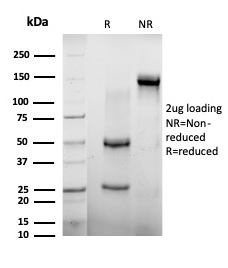Learn about our comprehensive antibody validation methods to ensure monospecificity. Antibody Validation>>

SDS-PAGE Analysis of Purified AGO3 Mouse Monoclonal Antibody (PCRP-AGO3-1C5). Confirmation of Purity and Integrity of Antibody.

Flow cytometric analysis of PFA-fixed HeLa cells. AGO3Mouse Monoclonal Antibody (PCRP-AGO3-1C5) followed by goat anti-mouse IgG-CF488 (blue); isotype control (red).
This antigen is involved in binding and translation repression of short RNAs. This antigen is also known as argonaute RISC catalytic component 3.Required for RNA-mediated gene silencing (RNAi). Binds to short RNAs such as microRNAs (miRNAs) and represses the translation of mRNAs which are complementary to them. Proposed to be involved in stabilization of small RNA derivates (siRNA) derived from processed RNA polymerase III-transcribed Alu repeats containing a DR2 retinoic acid response element (RARE) in stem cells and in the subsequent siRNA-dependent degradation of a subset of RNA polymerase II-transcribed coding mRNAs by recruiting a mRNA decapping complex involving EDC4. Possesses RNA slicer activity but only on select RNAs bearing 5'- and 3'-flanking sequences to the region of guide-target complementarity.
There are no reviews yet.